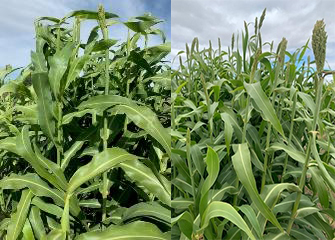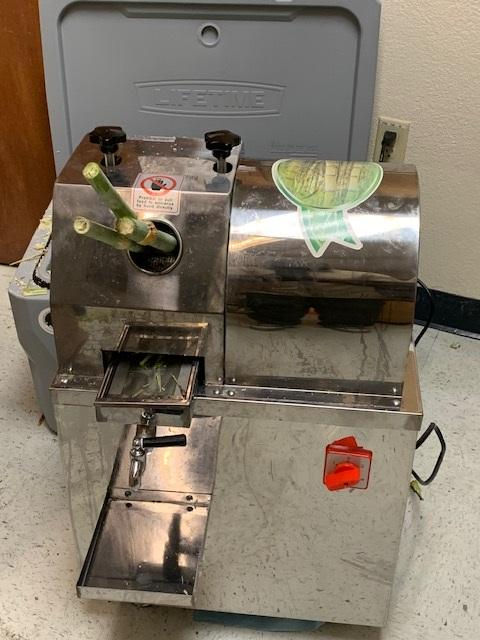Abstract
Sweet sorghum is a crop with multiple uses and can be a viable alternative crop with the main purpose of producing ethanol in Nevada’s water-limited environment. However, adaptation and production potential are critical information required by producers before deciding on the adoption of alternative crops. Four sweet sorghum varieties (Dale, M81-E, Sugar Drip and Topper-76-6) were evaluated in a field trial for ethanol production (extracted juice and bagasse) and feed quality of bagasse in Reno, Nevada. Estimated ethanol yield from the extracted juice ranged from 1,106 to 3,559 liters/hectare among the four sweet sorghum varieties and was greatest for the variety ‘Sugar Drip’. The estimated bagasse ethanol yield was similar among the four varieties (average = 4,502 liters/hectare). Based on the total ethanol yield (juice and bagasse) from this single-production-year data, all four sorghum cultivars can be used for ethanol production in western Nevada.
Introduction
The production of biofuel feedstocks can be a viable alternative cropping system for water-limited environments such as Nevada by using less water-demanding crops with overall low agronomic input requirements (e.g., fertilizer and water use) to optimize yield. Such a crop production focus could lead to the development of a localized biorefinery and thus expand economic opportunities in these regions. For crop production agriculture to remain sustainable in water-limited environments, a major focus must be on transitioning from high water-demanding crops, such as alfalfa (Medicago sativa L.), to less water-demanding crops with the potential to garner advantageous economic benefits.
Sweet sorghum [Sorghum bicolor (L.) Moench] is a utility crop because of its value as a renewable source of sucrose (syrup), lignocellulosic biomass (feedstock) and readily fermentable saccharides (sugars) in its stalk (stem) that can be converted into liquid transportation fuels (ethanol) and other bio-based products (e.g., bio-butanol) (Broadhead and Freeman, 1980; Erickson et al., 2012). The bagasse (pulpy fibrous remains of the stalk after juice extraction) can be used for lignocellulosic ethanol conversion, combustion energy, silage (animal feed) and paper (Whitfield et al., 2012). In addition, sweet sorghum is less demanding as a food or feed crop relative to corn and as such mitigates the issue of food-feed-fuel conflicts. Some outstanding agronomic traits of sweet sorghum are its drought tolerance, high water-use efficiency, low nitrogen requirements, high yield potential (juice and biomass) and composition (sucrose, fructose, glucose), short growing period, wide adaptability on marginal cropland, and fits easily into crop rotation schemes (Rooney et al., 2007; Sakellariou-Makrantonaki et al., 2007; Tamang et al., 2011).
In 2023, the United States produced 15.6 billion gallons of ethanol, of which an estimated 38% of the total corn produced was used for ethanol production (U.S. EIA, 2023; USDA-ERS, 2024). Of the total ethanol produced annually, corn grain starch accounted for 93.8% (RFA, 2022). Ethanol consumption in the United States is projected to increase by as much as 10.4% by 2030 (Ramsey et al., 2023), and thus a crop such as sweet sorghum can fulfill the role of meeting this ethanol demand. Therefore, the adoption of a biofuel crop production system using sweet sorghum can allow producers to carve out a niche farming system in marginal production environments such as Nevada that sustains the livelihood of farming communities. However, no data is available on sweet sorghum production in Nevada, and as such, baseline data on sweet sorghum production performance in Nevada will be critical in the decision to adopt and integrate this crop in a sustainable biofuel cropping system. This varietal evaluation in a field trial sought to assess the ethanol production potential of sweet sorghum in Nevada’s water-limited environment.
Materials and Methods
Experimental site: This one-year sweet sorghum varietal evaluation was conducted at the University of Nevada, Reno Main Station Field Laboratory, in Reno, Nevada, during the summer of 2023. Total precipitation during the growing season from June to September of 2023 was 2.4 inches (61 mm).
Soil type and analysis: The soil type was a Truckee silt loam.
Sweet sorghum varieties and experimental design: Four sweet sorghum varieties (‘Dale’, ‘M81-E’, ‘Sugar Drip’ and ‘Topper 76-6’; Source: MAFES Foundation Seed Stocks, MS State, MS; Figure 1a) were laid out in a randomized complete block design experiment with four replications of each variety. Each plot was 30 feet long by 5 feet wide and separated by a 10-foot alleyway between plots and 20 feet between blocks. Each variety was seeded in a prepared seedbed at a rate of 4 pounds pure live seed per acre on June 20, using a Wintersteiger Plotseed XL seeder in narrow rows 8 inches apart. Note: can be seeded from the last week of May in this area and typically, 30-inch row spacing is recommended.
 Figure 1a. Sweet sorghum varieties evaluated in the field trial.
Figure 1a. Sweet sorghum varieties evaluated in the field trial. Figure 1b. Electrical sugarcane juice extractor.
Figure 1b. Electrical sugarcane juice extractor. Figure 1c. Extracted juice collection and measurement.
Figure 1c. Extracted juice collection and measurement. Figure 1d. Bagasse collection after juice extraction.
Figure 1d. Bagasse collection after juice extraction.
Figure 1. Sweet sorghum is grown and processed.
Crop management: Irrigation was done through a solid-set sprinkler system once a week for the first three weeks after sowing, and thereafter, every 14 days based on reference evapotranspiration data. Based on the soil test recommendation, phosphorus was applied at a rate of 60 pounds P2O5/acre (triple superphosphate) two days before sowing. Nitrogen was applied once at 80 pounds/acre (urea) three weeks after germination. In crop, broadleaf weed control was carried out once using 2,4-D amine.
Data collection: The parameters collected were leaf area index (LAI) at 80 days after sowing (LAI Plant Canopy Analyzer), plant height (from ground to top of grain head on three randomly selected plants in the center of each plot) and stem diameter at harvest using a digital caliper close to the stalk's base, middle and upper portion of the stem (three plants from middle rows).
Sweet sorghum stalk biomass was determined from a 24-square-foot (2.2 m2) area in each plot using a sickle bar mower cut to a 3-inch stubble height. The freshly harvested stalks (hard dough stage) were stripped of leaves and the panicles were removed from each before weighing the stalk and leaf separately (the panicle was not quantified because of feeding by birds). All stalks in the area sampled for biomass were used in the juice extraction process using an electrical sugarcane juice extractor (Figure 1b).
Three randomly selected whole plants were separated into stalk (stem) and leaf for dry matter determination and to quantify the proportion of stalk and leaf on a dry matter basis. The volume (liter) and mass (kilogram) of juice from each plot were recorded (Figure 1c). After juice extraction, Brix (percentage soluble solids; or a measure of dissolved sugar to water mass ratio of a liquid) readings were collected from the juice of each variety replication using a Digital Hand-held Pocket Refractometer. The bagasse (stalk fiber) that remained after juice extraction from each variety replication was weighed fresh and recorded (Figure 1d).
Dry matter and nutritive value determination: A subsample of approximately 1000 grams fresh weight of the bagasse from each plot was collected for dry matter determination and fiber analysis. The subsamples for the leaf, stalk and bagasse were oven-dried at 60 C for either 72 (leaf) or 120 hours (stalk and bagasse). Stalk and leaf yield were calculated fresh and on a dry matter basis using the dry matter percentage of each component. Each subsample (leaf and bagasse) was ground separately using a Wiley mill (Model 4, Thomas Scientific, Swedesboro, NJ) to pass a 1-millimeter screen and stored in Whirl-Pak sample bags. Neutral detergent fiber (NDF; samples boiled in 2 liters of neutral detergent solution for 75 minutes) and acid detergent fiber (ADF; samples boiled in 2 liters of acid detergent solution for one hour) analyses were done according to the ANKOM procedure. The following formulas were used to quantify the hemicellulose and cellulose fractions: Hemicellulose = NDF% - ADF%; and Cellulose = ADF% - ADL. Acid detergent lignin (ADL) was not quantified on this study's leaf (2.5%) and bagasse (10.2%) component, but we used mean values in parentheses for sweet sorghum reported in other studies (Tang et al., 2018; Nazli, 2020). Forage quality indicators for the leaf and bagasse of each sorghum variety were determined based on the formulas: Digestible dry matter (DDM) = 88.9 - (.779 x %ADF) and Dry matter intake (DMI) = 120 / %NDF.
Estimation of sugar and ethanol yield: Estimated sugar and ethanol yields from juice and bagasse were derived using the following equations (Wortmann et al., 2010; Teetor et al., 2011; Tang et al., 2018).
Equation 1: Conservative sugar yield (CSY; kg ha-1) = JY × Brix%/100 × 0.75
CSY = Conservative sugar yield (kg ha-1), JY is juice yield (kg ha-1), and the conversion factor 0.75 (75%) is the estimated proportion of Brix that is fermentable sugar.
Equation 2: Theoretical ethanol yield (TEY) from sugar (L ha-1) = CSY × 0.58
TEY is the theoretical ethanol yield, and the conversion factor of 0.58 L is the liter of ethanol derived from 1 kg of sugar.
Equation 3: TEY (bagasse; L ha-1) = (Cellulose (%) + Hemicellulose (%)) × Dry Biomass × 0.58 × 0.85 × 1.11 × 0.85 × 1000/0.79 g mL-1
TEY (biomass) represents the theoretical ethanol yield derived from cellulose and hemicellulose of the sweet sorghum biomass, 0.58 represents the coefficient of a conversion factor of ethanol from sugar, 0.85 represents the process efficiency of sugar from cellulose and hemicellulose or process efficiency of ethanol from sugar, 1.11 represents the coefficient for the conversion factor of sugar from cellulose and hemicellulose, and 1000/0.79 g mL−1 represents the specific gravity of ethanol.
Statistical analysis: Variety means for each measured or estimated parameter were compared statistically using the least significant difference (LSD) test at the probability level of alpha = 0.05. The LSD value for means comparison among each parameter represents the minimum value between any two varieties to determine if the difference was due to variety only. Data was analyzed using the General Linear Model (GLM) procedures of SAS version 9.4 (SAS Institute, 2015).
Conclusions
As a cautionary note, producers should be mindful that the conclusions are based on results from a single crop year and environment and that generally, varietal differences are known to vary across years and environments. However, the results from this evaluation indicated that Sugar Drip performed best for juice ethanol yield, but the combined total ethanol yield (juice and bagasse) indicated that all four varieties are suitable for this growing environment. The quantity of leaf and bagasse biomass produced and their feed quality indicators among the four sweet sorghum varieties offer a valuable source of animal feed for ruminant livestock in water-limited environments such as Nevada. Overall, the comparable production responses of the four sweet sorghum varieties to other growing environments indicate that this crop can be a suitable alternative crop to integrate into Nevada’s crop production agriculture. Further evaluations will be carried out across multiple environments in Nevada to ascertain on a wider scale the productive potential of sweet sorghum in this state.
Please contact the authors listed below for the complete PDF version with tables included.


